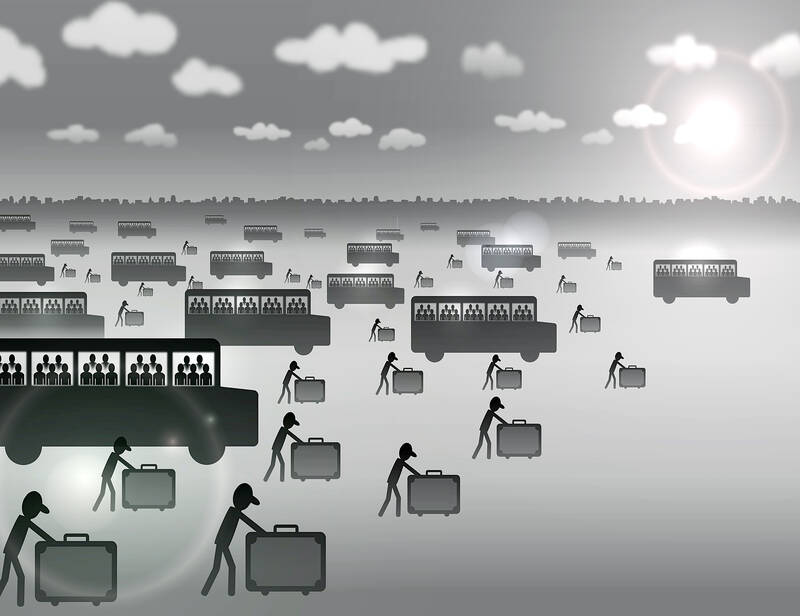Disinformation is filling the vacuum left by an absence of a national discussion on the growing influx of foreigners
By Gearoid Reidy / Bloomberg Opinion
You might have read that Japanese Prime Minister Shigeru Ishiba is planning to “import millions of Africans and Kurds” into Japan — and that this is why he is stepping down.
Maybe you have seen the plans for Tokyo to designate special “hometowns” within the country that would become free havens for African immigrants on special visas. Or perhaps the recently announced suggestion to bring in half a million Indians into the country?
There is a common thread to these stories: They are all complete fiction. There is no mass immigration from the global south into Japan, although you might not know that if you primarily consume your news on social media.

Illustration: Yusha
However, these stories fill a vacuum — the lack of a proper discussion on immigration. It is one that should be at the center of the race to be the next prime minister.
Perhaps because it is an outlier among developed nations when it comes to immigration, with foreigners making up just 3 percent of the population, these kinds of lies thrive on social media. The Japanese Web has its own share, of course, but strangely much of this is in English — shared by people like Elon Musk, who said this week that Ishiba would go down as the “greatest criminal in the entire history of Japan” if he went ahead with his fictional mass-migration plans.
Musk represents a particular sort of naive reader with no particular stake in or knowledge of the country, who nonetheless sees “Japan is fallen” narratives in every post.
On his X social media platform, it is common to see videos and images that misrepresent or lie outright about the situation. This amplified content is easy money for engagement accounts — even my own most-viewed post was on this subject.
The noise threatens to drown out legitimate debate over the country’s stance toward immigration. Bank of Japan Governor Kazuo Ueda said in a speech that foreigners’ contribution to labor force growth last year from a year earlier was more than 50 percent. With typical understatement, he added that “further increases would require a broader discussion.”
It is time for that broader discussion to begin. Two years ago, I wrote about how Japan had been quietly adding more immigrants than most thought. That silence was deliberate; the government announced no policy shift when it began changing its posture in the mid-2010s under the late former Japanese prime minister Shinzo Abe.
However, foreign labor is an unavoidable necessity. With the working age population having peaked years ago, Japan is facing a growing labor crunch. Yet the change might be too rapid: The number of residents from overseas has doubled since the middle of the past decade, likely already surpassing 4 million in a nation of 124 million.
A report released in 2023 predicted that foreigners would make up 10 percent of the population, around the Organisation for Economic Co-operation and Development average, by 2070. Officials this year brought that forward by three decades.
It is no wonder then that citizens feel somewhat blindsided. As I wrote before the recent upper house election, the minor shift in support for the right-wing party Sanseito is far more a vote against Ishiba’s Liberal Democratic Party than one in favor of cracking down on foreigners. Yet it is also true that Sanseito has thrust into the public sphere a conversation many wanted to have.
Japan has largely not made the same mistakes on immigration as other countries, regardless of what is posted online. Immigrants in Japan are generally productive members of society, not housed in “asylum hotels” or overflow shelters or showing up in dinghies. Indeed, one of the key differences is that Japan is seeing immigration not of the impoverished, but of a large, rich Chinese middle-class — who can often afford to outspend locals.
To continue to avoid these mistakes, there are some things the country needs to do — and it should use the upcoming debates to replace Ishiba as leader as the starting point.
The first is to have a conversation about what Japan should look like. Many nations failed to do this before radically changing their policies, while those with valid concerns were often dismissed. Japan can avoid that.
The discussion also needs to be honest. Toshimitsu Motegi, who on Wednesday last week formally declared his candidacy to replace Ishiba, called for building a society that “doesn’t need to depend” on foreign workers. Hopefully his rivals bring more realistic policies.
The second is to break down the contradictory and uncoordinated policies around immigration, which involve a half-dozen ministries and agencies. Reducing dependence on foreigners is not a realistic option, so the government needs real plans to avoid ghettoization and to assimilate those who arrive, rather than hope they would go away.
It should also recognize that Japan has changed; having struggled to attract immigrants for years, it is now a desirable destination. That means adjusting everything from property rights and healthcare to attaining citizenship (sometimes considered easier than permanent residence.) It is only in the past few months that politicians have started attempting to coordinate these policies. A national strategy is needed.
Finally, government figures must be mindful of public perception. The African “hometown” story was halfway around the world while the official response was still lacing up its boots. Politicians must expect their words might be twisted on social media and consider how, without a national strategy, misinformation would always fill the void.
Gearoid Reidy is a Bloomberg Opinion columnist covering Japan and the Koreas. He previously led the breaking news team in North Asia, and was the Tokyo deputy bureau chief. This column reflects the personal views of the author and does not necessarily reflect the opinion of the editorial board or Bloomberg LP and its owners.